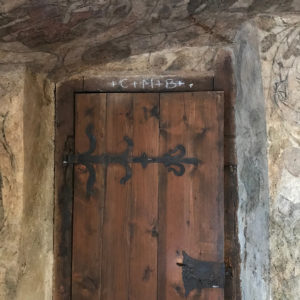
We approach the close of the Twelve Days of Christmas. This Eleventh Day of Christmas has no particular traditions associated with it, but tonight is a different story, for this evening’s setting sun brings Twelfth Night, the Eve of the Epiphany. Epiphany marks the arrival of the Magi at the stable. Three wise men, strangers from distant lands. As such, they represent the manifestation of the child to the larger world, the world beyond the village of Bethlehem. They follow that star and repeat the sounding joy to all the world.
In fact, Epiphany is a much older celebration than Christmas. In the early days of the Church, the Nativity and the Epiphany were celebrated together on the 6th day of January. It wasn’t until the Council of Tours, in 567, that the two feasts were formally separated, with Christmas set on the 25th of December. Here in the States, our celebration focuses on Christmas Day, but in other places, this whole season is a time outside ordinary time, concluding only with the passing of Epiphany. And here’s what that might look like: a big feast tonight for Twelfth Night, which might include a big cake and in it, a bean or a whole nut or a trinket. The person who finds it is honored for the night with a suitable title, such as the King or Queen of the Bean. It’s a raucous night of revelry, typically accompanied by a good deal of ale or cider or wine. None of this stuff sat well with the Puritans, so while they ruled England, all of it was banned. Even Christmas itself.
Twelfth Night was never a big deal in our home, either. But Mom, who perhaps shares more of my enthusiasm for obscure holy days, has always called Epiphany, since I can remember, “Little Christmas,” and even as a kid, when I’d get a little sad about the passing of Christmas Day, she would be quick to remind me that we still had Little Christmas ahead of us. This always lifted my spirits. After I did a printing internship at the Sabbathday Lake Shaker Community and began learning more about Shaker Christmas traditions, what intrigued me most was their celebration of Twelfth Night each year. Each year, I’d ask Brother Arnold more questions, until finally we began having our own Twelfth Night celebrations. Sometimes they are big dinner parties and sometimes they are quiet gatherings. It generally depends on how much energy we have left at the tail end of a hectic Christmastime (and how much rich food we’ve eaten over the course of the Twelve Days). This year will be a quiet one, probably just the four of us: my mom, my sister, and Seth and me, and that feels, this time around, just right.
The highlight of our celebration will come with nightfall: we will gather outside the front door, whether it be cold or warm, with a step stool and a piece of chalk. In years past, the chalk was blessed by Father Brice, the parish priest, but Father Brice is dead and gone these ten or fifteen years now, and I’ve not heard a word about blessed chalk in any church since, no matter how much the building smells of incense and wonder. And so regular old chalk works just as well. Out on the front porch, standing on the step stool, we will each take turns writing the letters and numbers and symbols of an old inscription on the lintel above the door. This year, it will read 20+C+M+B+20. It’s the year (2020) and within the year, punctuated by crosses, come the initials of the Magi. Their names, handed down to us through tradition over the ages, were Caspar, Melchior, and Balthasar.
It was that same Father Brice who taught us this tradition, and few and far between are the homes whose inhabitants seem to know it. But this past summer, when Seth and I were in Austria and Germany and Switzerland, I was pleased to see the inscription on doorways throughout the towns where we wandered. For me, on our front porch and on the porch of my family’s home, the inscribing is always accompanied by a silent prayer that no one will be missing when we gather next year to write the inscription again. Depending on the weather, the inscription may be there above the door for a month or it may be there all the year through. And though Christmas be gone, still the inscription reminds us of its presence as we pass each day through that portal. The inscription is a magic charm of sorts, protecting the house and those who pass through that doorway, harboring the goodwill and spirit of Old Father Christmas.
Ah but that is on Epiphany. Tonight, on the Eve of the Epiphany, Twelfth Night, the last of the Midwinter gift bearers will make their rounds. In Italy, la Befana, the kindly witch, will be on her broom, and in Latin America, los Tres Reyes, the Three Kings, will be traveling by camel. Their stories are intertwined. The Magi arrived at the stable with gifts for the child, and so they continue to bring gifts to children in the lands where they are most loved. In Italy, though, the legends get a little more interesting. It is said that the Magi stopped at la Befana’s cabin to ask for directions. They found her sweeping her floor. While they were there, they asked her to join them on their journey. “No, no,” she told them, “I’m too busy with my housework!” And so the Magi went on their way. But as she swept, la Befana grew remorseful that she had not gone with them, and so she stopped her sweeping, hopped on her broom, and left her home in search of the Magi and the child. But she never found them. Each year on the Eve of the Epiphany, she sets out on her journey again, in search of the child, delivering small presents to good boys and girls, and coal for the not so good ones. And it is la Befana who sweeps away Christmas for another year.
I have known so many Befanas in my day. It comes with the territory when you are of Italian descent. Women and men who clean and clean and clean, and who take great pride in their clean homes. My grandmother’s neighbor Tessie was known to roll the refrigerator away from the wall each and every day just so she could sweep behind it. All that cleanliness is a wonderful thing, of course, but you know each of these people would’ve said no to the Magi, too, just like la Befana herself did at that first Christmas. Would they, too, grow remorseful? Where does she even come from, la Befana? Well, she is an old hag… and so is the earthly goddess at Midwinter in the circular wheel of the year: Born in springtime, fair maiden in summer, mother in autumn, old woman in winter. A cycle repeating with each orbit around the sun, the story told again and again. Come Candlemas, at the start of February, when it is traditional to have every last vestige of Yuletide greenery removed from our homes, she will be reborn as Brigid, bridging us from winter to spring. The story never grows old.
Photo: A door within the chapel at the medieval Schattenburg Castle in Feldkirch, Austria. The castle was built in the 13th century. We saw inscribed doors throughout our travels in this part of Europe. This one didn’t have the date, just the initials, but all the other inscribed doors we saw had dates ranging from 2015 to 2019. Perhaps it just depended on who was living in each dwelling.


